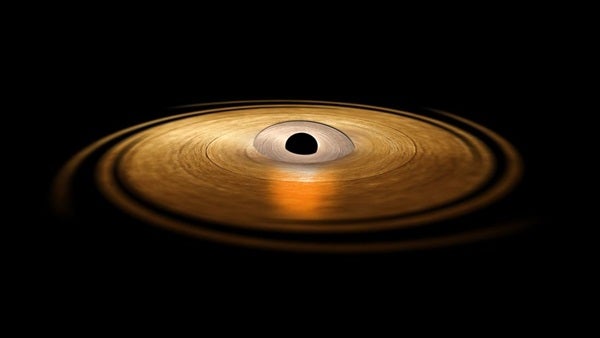A European Space Agency (ESA) project recently detected the effects of the gravitational vortex, or “frame dragging,” around black hole H1743-322, thus confirming another prediction of general relativity.
Measuring the gravitational vortex around black hole H1743-322 was possible because the plane of its accretion disc of gas and dust is slightly tilted from the equatorial plane of the spinning black hole. The tilt makes the “inner flow” of hot gas closest to the black hole precess as it orbits at almost 20 percent of the speed of light. Precession is the slow movement of the axis of rotation, somewhat like the motion of a gyroscope.
Gravity Probe B, launched in 2004, measured the gravitational vortex in its orbit around Earth. The precession cycle, or the time it takes for the axis of rotation to come back around to the same position, for Gravity Probe B in Earth’s gravity field was 33 million years. The plasma inner flow around black hole H1743-322 completes a precession cycle in 4 seconds because of the much stronger gravitational field.
This is the first time that precession in a gravitational vortex has been measured in a strong gravitational field. Adam Ingram, of the University of Amsterdam, was lead author of the paper in the Monthly Notices of the Royal Astronomical Society, first published online May 25, 2016. The print version has not yet been published.
Luckily for astronomers, the material around a black hole sends out signals. Matter spiraling into a black hole heats up. In fact, the inner flow can reach millions of degrees before it disappears from view into the black hole. At that temperature it shines X-rays into space.
Astronomers had observed a periodic oscillation in the brightness of X-rays emitted from the hot inner flow of a black hole as early as the 1980s. They even gave it a name: the quasi periodic oscillation (QPO). They did not understand what was causing the oscillations, though. Adam Ingram, of the University of Amsterdam, and his colleagues published a paper in 2009 suggesting that the QPO was driven by the precession of the hot inner flow.
Looking at the X-rays from the inner flow was inconclusive, though, because they are emitted in a more or less continuous spectrum of frequencies.
“Precession of this inner flow certainly would cause the observed X-ray continuum to get brighter and dimmer on the precession period as we see different parts of the inner flow,” says Ingram. “But all we can tell from looking at the continuum is that the X-rays are getting brighter and dimmer on a period of (in this case) about 4 seconds.”
What they needed was a more precise indicator, and H1743-322 supplied it. Inner-flow X-rays hitting the accretion disc excite iron atoms in the disc, and the iron atoms in turn emit X-rays of a consistent 6.4 kilo electron volts (keV) — at least, the X-ray photon is 6.4 keV in the iron atom’s rest frame. The photon loses energy while climbing out of the black hole’s gravity well. It also gains or loses energy depending on whether it is emitted from the part of the accretion disc that is moving toward or away from the observer, in this case the European Space Agency’s orbiting X-ray observatory called XMM-Newton and NASA’s Nuclear Spectroscopic Telescope Array (NuSTAR).
“In order to model this kind of thing, we therefore need to account for special and general relativistic effects,” explains Ingram. “The hardest thing to account for is a general relativistic effect: light bending. The gravitational pull of the black hole is so strong that the photons do not travel in straight lines. Very close to the black hole, the photon paths can be very bent indeed.”
The iron spectral line gets distorted, but it is decipherable.
“It is the iron line that provides a unique signature of precession,” says Ingram. “The fact that we see the line energy move from red-shifted to blue-shifted each QPO cycle tells us that the disc cannot be axi-symmetrically illuminated. Instead, the inner flow is preferentially illuminating different parts of the disc as it precesses. It is very difficult to reproduce this behavior of the iron line with a process other than precession, and so this line energy modulation is by far the best evidence we have that these brightness oscillations are caused by precession.”
“The fact that we can see variations in the iron line provides some much-needed physical constraints to the phenomenology of quasi-periodic oscillations,” says Erin Kara, a postdoctoral researcher at NASA’s Goddard Space Flight Center in Greenbelt, Md., and the University of Maryland, College Park. “The iron line is a powerful diagnostic for probing the dynamics of the accretion disc. So finding a connection between QPOs and a changing iron line is a really important step.”
If the plane of the accretion disc had been aligned with the equator of the spinning black hole, there would have been no iron X-rays to capture and analyze. So, with a bit of luck and some careful calculations, astronomers have confirmed another prediction of Albert Einstein’s general theory of relativity.
Allen Zeyher is a freelance writer in the Chicago area.










